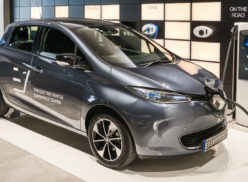On March 19, China’s State Administration for Market Regulation (SAMR) published a notice titled “Taking a Step Forward in Strengthening the New Energy Vehicle Product Recall Supervision.” The notice contained a range of new regulations designed to tighten up safety standards in the Chinese New Energy Vehicle (NEV) market, following a spate of fires and accidents involving NEVs.
The NEV classification refers to vehicles that qualify for China’s national policy to support the uptake of battery electric vehicles (BEVs), plug in hybrid vehicles, and fuel cell vehicles. The NEV regulation is similar to the California Zero Emission Vehicle (ZEV) mandate, in that it is a credit-based program that forces manufacturers to supply the market with a fixed quantity of qualifying vehicles by a certain year. The Chinese NEV mandate is targeting 12 percent NEV credits by 2020—which would translate to NEV vehicles making up anywhere between 2 and 12 percent of all passenger vehicle sales in 2020 depending on credit distribution and allocation. The International Council on Clean Transportation estimates that NEVs will make up roughly 6 percent of all Chinese passenger vehicle sales by 2020.
The regulation contains four main rules that came into effect as of March 19. First, manufacturers, importers, and retailers must investigate, analyze, and report the results of collisions, fires, and other issues to the SAMR. Second, manufacturers of batteries and other vital components must report defects to the SAMR and automakers and retailers. Third, manufacturers and component makers for NEVs located outside of China’s borders that produce for the Chinese market must also report defects to the SAMR. Finally, the regulation stipulates that OEMs of NEVs must develop supply chain supervision and management systems that allow them to take responsibility for the quality and safety of their products.
Fires and recalls
There were at least 40 incidents of NEV fires in 2018. Already in 2019 three Beijing Electric Vehicle (a subsidiary of state-owned BAIC) vehicles of the same model have caught fire. Although reporting on NEV fires is quick to mention that the new regulations will apply to both domestic and international brands, there are indications that Chinese domestic vehicles are having more problems than international ones. In 2018, Beijing Automotive Works (also a subsidiary of BAIC) recalled nearly 70,000 BEVs due to faulty braking and other issues.
The Chinese government’s annual recall list contains the details for 169 recalls involving 12,323,722 vehicles. Approximately 136,000 new energy vehicles were recalled in the Chinese market in 2018, 89 percent of which were made by Chinese companies. Although the list doesn’t explain each specific recall, the top reasons, as listed by another article, were batteries, brakes, and gearboxes.
Commentators note that the combination of lax regulation and the current subsidy design are partially to blame for the trend. In an attempt to boost range (and thus unlock higher subsidy values), domestic manufacturers have been packing as much battery capacity into vehicles as possible without necessarily considering how those changes impact consumer safety. The Chinese government is expected to decrease subsidies by about 30 percent this year before totally phasing out subsidies by 2020.
“In the pursuit of subsidies, certain manufacturers are leaving security risks.”
Ouyang Minggao, Executive Vice President of the ChinaEV100, a think tank aimed at boosting the development of the Chinese EV industry, was recently quoted as saying that “in the pursuit of subsidies, certain manufacturers are leaving security risks.” One of these risks is thermal runaway, in which an increase in temperature changes conditions in a way that causes a further increase in temperature, which Minggao notes is a leading cause of NEV fires.
If standards are applied evenly among market participants, stronger safety recall regulations in the Chinese market could help international automakers. Recall numbers skew heavily towards international brands in the Chinese market. Of the 12 million cars that were recalled in the Chinese market in 2018, 37, 30, and 15 percent were made by American, German, and Japanese companies respectively. By contrast, only 10 percent were produced by Chinese companies. According to the Financial Times, analysts and executives do not think this skew is representative of quality, but rather because of differences in reporting standards and a penchant among Chinese automakers to avoid negative branding at all costs. Unfortunately, the Chinese government is incentivized to unevenly enforce regulations to the benefit of Chinese automakers, given the large stakes that national, state, and city governments hold in most domestic automakers and the nation’s goal of becoming a powerhouse for global EV production by 2025.
Although this may seem like bad news for international firms, there is still a silver lining. By maintaining high standards and patiently testing vehicles before they go to market, global automakers have an opportunity to distinguish themselves from their Chinese rivals. This is particularly true when poorly-made domestic NEVs are failing to win consumers over. From self-combusting vehicles to a number of Dongfeng (a state-owned company) customers who found that their E70s only make it 150 of the originally-advertised 500 kilometers on a charge, there is a chance for strong international brands to compete on merit even in the distorted Chinese market.







